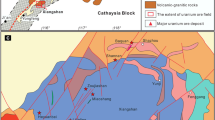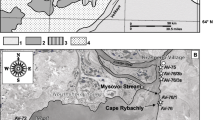Abstract
Five lamprophyre dikes (L1-L5) intruded Abu Rusheid rocks (cataclastics and monzogranite) in the South Eastern Desert of Egypt along shear zones with NNW-SSE and E-W. The two sets of dikes differ in age, mineralization, and geochemical aspect. The NNW-SSE trending dikes (L1 and L2) are polymineralized and dislocate the E-W (L3, L4, and L5) trending dikes. These dikes underwent multistage of hydrothermal processes (ferrugination, fluoritization, kaolinitization, and calcification). They are characterized by common box works (physical trap) filled by incoming mineralization, and their feldspars and micas are relatively altered to clay minerals (chemical trap). From the mineralogical point of view, the cataclastic rocks are rich in base metals (pyrite, sphalerite, molybdenite, chalcopyrite, and galena), radioactive minerals (thorite, uranophane, kasolite, uranothorite), and accessories phases (zircon, xenotime, cassiterite, molybdenite, copper, columbite, and fluorite). L1 and L2 lamprophyre dikes contain U minerals (uranophane, kasolite, autunite, and torbernite), Mn-franklinite, woodruffite, xenotime, fluorite, silver, copper, and scheelite. L3 contains Zn and U minerals, whereas L4 and L5 contain Zn minerals only. The source magma producing lamprophyre dikes (L1 to L4) are peralkaline to alkaline, whereas L5 lamprophyres are mainly calc-alkaline in character; they were generated from the mantle and had formed in a post-collision tectonic setting with extensive Ti-rich metasomatism. The average ΣREE content in (L1 and L2) lamprophyres is 8006 ppm. REE patterns display clear concave upward pattern of W-type tetrad effect in the REE pattern accompanied by enrichment of the HREE over the LREE and marked negative Eu anomaly due to secondary mobilization of REEs.











Similar content being viewed by others
References
Alderton DH, Pearce JA, Potts PJ (1980) Rare earth elements mobility during granite alteration: evidence from Southwest England. Earth Planet Sci Lett 49:149–165
Assaf HS, Ibrahim ME, Zalata AA, El-Metwally AA, Saleh GM (2000) Polyphase folding in Nugrus-Sikait area south Eastern Desert, Egypt. JKAW: Earth Sci 2000(12):1–16
Awad NT (1994) Kyanite in quartz segregation in the Central Eastern Desert, Egypt. Egypt Miner 6:77–94
Bau M (1999) Scavenging of dissolved yttrium and rare earths by precipitating iron oxyhydroxide: experimental evidence for Ce oxidation, Y-Ho fractionation, and lanthanide tetrad effect. Geochim Cosmochim Acta 63:67–77
Boynton WV (1984) Geochemistry of the rare earth elements: meteorite studies. In: Henderson, P. (ed.), Rare earth element geochemistry, Elsevier, 63-114
Cox KG, Bell JD, Pankhurst RJ (1979) The interpretation of igneous rocks. George Allen and Unwin, London
Eyal Y, Eyal M (1987) Mafic dyke swarms in the Arabian-Nubian Shield. Isr J Earth Sci 36:195–211
Foley SF, Venturelli G, Green DH, Toscani L (1987) The ultrapotassic rocks: characteristics, classification, and constraints for petrogenetic models. Earth-Sci Rev 24:81–134
Hashad AH, Hassan MA (1959) Report on the prospection work carried out in Wadi El Gemal area, south Eastern Desert, Egypt. Internal Report, AEE, Cairo, UAR
Hassan MA (1964) Geology and petrographical studies of the radioactive minerals and rocks in Wadi Sikait-Wadi El Gemal area. Eastern Desert, U. A. R: M. Sc. Thesis Faculty of Science, Cairo Univ.1964, 165
Hassan MA (1973) Geology and geochemistry of radioactive columbite-bearing psammitic gneiss of Wadi Abu Rusheid. South Eastern Desert, Egypt. Ann Geol Surv Egypt III:207–225
Ibrahim ME, Saleh G, Rashed M Watanabe K (2007b) Base metal mineralization in lamprophyre dykes at Abu Rusheid area, south Eastern Desert, Egypt. The 10th Inter. Min., Petrol., and Metall. Eng. Conf. March 6–8. Assuit Univ., 56-67
Ibrahim ME, Saleh GM, Dawood NA, Aly GM (2010) Ocellar lamprophyre dyke-bearing polymineralization at Wadi Nugrus, Eastern Desert of Egypt: mineralogy and geochemical implications. J Geol Min Res 2(4):74–86
Ibrahim ME, Saleh GM, El-Tokhi MM, Rashed M (2007a) A Lamprophyre bearing-REEs in Abu Rusheid area, Southeastern Desert, Egypt. The 7th International Conference on Geochemistry, Alexandria University., 30-41
Ibrahim ME, Abd El-Wahed AA, Rashed MA, Khaleal FM, Mansour GM, Watanabe K (2007c) Comparative study between alkaline and calc-alkaline lamprophyres, Abu Rusheid area, south Eastern Desert, Egypt. The 10th Inter. Min., Petrol., and Metall. Eng. Conf., Assuit Univ., 99-115
Ibrahim ME, Assaf HS, Saleh GM (2000) Geochemical alteration and spectrometric analysis in Abu Rusheid altered uraniferous gneissose granites, South Eastern Desert, Egypt. Chem Erde 60:173–188
Ibrahim ME, Saleh GM, Hassan MA, El-Tokhi MM, Rashed MA (2007d) Geochemistry of lamprophyres bearing uranium mineralization, Abu Rusheid area, south Eastern Desert, Egypt. The 10th Inter. Min., Petrol., and Metall. Eng. Conf., Assuit Univ., 41-55
Ishikawa Y, Sawagushi T, Jwaya S, Horiuchi M (1976) Delineation of prospecting targets for Kuroko deposits based on modes of volcanism of underlying dacite and alteration holes. Min Geol 26:105–111, in Japanese with English abs
Khalel FM (2005) Geologic evolution of some rare metal resources in Nugrus-Sikait area, Eastern Desert, Egypt. Ph.D. Thesis, Al Azhar Univ., 200, 168
Large RR, Gemmell JB, Paulik H (2001) The alteration Box Plot: a simple approach to understanding the relationship between alteration mineralogy and lithogeochemistry associated with volcanic-hosted massive sulfide deposits. Econ Geol 96:957–971
Monecke T, Kempe U, Monecke J, Sala M, Wolf D (2002) Tetrad effect in rare earch element distribution patterns: a method of quantification with application to rock and mineral samples from granite-related rare metal deposits. Geochim Cosmochim Acta 66:1185–1196
Osman RA, Osman AM, Ibrahim ME (2007) REE geochemistry of mineralized mylonitic granites at Abu Rusheid area, southeastern Desert Egypt. Sci. J. Fac. Sci., Minoufiya Univ., XXI, 143-158
Rock NMS (1991) Lamprophyres: Glasgow and London, Blackie and Son Limited, 285
Saleh GM (1998) The potentiality of uranium occurrences in Wadi Nugrus area, south Eastern Desert, Egypt. Ph. D. Thesis Mans. Univ., 171
Streckeisen A (1979) Classification and nomenclature of volcanic rocks, lamprophyres, carbonatites, and melilitic rocks: recommendations and suggestions of the IUGS Sub commission on the Systematics of Igneous Rocks. Geology 7:331–335
Taylor SR, McLennan SM (1980) The rare earth elements evidence in Precambrian sedimentary rocks: implication for crustal evolution in (ed. A. Kroner). Precambrian plate tectonic, Elsevier
Taylor SR, Arculus R, Perfit MR, Johnson RW (1981) Island arc basalts. In: Merrill RB, Ridings R (eds) Basaltic volcanism on the terrestrial planets, 193–213. Pergamon, New York
Acknowledgments
The authors appreciate the contribution from all members of Abu Rusheid project at NMA, Egypt. This work was financially supported by the Japan Society for the Promotion of Science during the first author's fellowship. The authors would like to express appreciation to Mr. Shinkawa at Mineral Resources Department, Kyushu University, Japan for all assistance during lab. Analyses.
Author information
Authors and Affiliations
Corresponding author
Rights and permissions
About this article
Cite this article
Ibrahim, M.EA., Watanabe, K., Saleh, G.M. et al. Abu Rusheid lamprophyre dikes, South Eastern Desert, Egypt: as physical-chemical traps for REEs, Zn, Y, U, Cu, W, and Ag. Arab J Geosci 8, 9261–9270 (2015). https://doi.org/10.1007/s12517-015-1882-8
Received:
Accepted:
Published:
Issue Date:
DOI: https://doi.org/10.1007/s12517-015-1882-8




